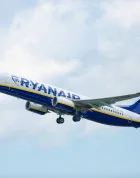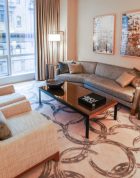For the last couple of months, in the background of the apocalyptic air travel climate, Air Canada has been quietly working on a new project behind closed hanger doors.
As you may have seen, some of their passenger aircraft have been converted to ad-hoc freighters by way of removing the seats in the passenger cabins. In one case, a particular aircraft did not have its original seats and fixtures re-installed when its stint as a cargo jet came to an end. Instead, this 20 year old Airbus A330 (C-GFUR, Fin 934) has been given new life with all new, updated cabins.

Air Canada A330 new business class – Cabin
If you’ve ever flown in the “Classic Pods” business cabin of Air Canada’s A330s and 767s, you probably know that those are a considerable departure form the business class Air Canada advertises. You might also agree with me when I say that those cabins are quite worn-out, antiquated, and generally not worth their value in neither cash nor miles.
Therefore, this updated cabin is a much needed replacement for what is becoming somewhat of a black sheep among frequent flyers and discerning travellers. It’s also in line with the company’s goal to unify all their cabins, and streamline services as much as possible.
Air Canada A330 New Business Class – Booking
I took the first aircraft (C-GFUR, Fin 934) to be updated with these seats. Over the next year, all 12 of the airline’s A330-300s should have completed their retrofits and be outfitted with these products. But for those of you who cannot wait, here are some ways you can catch this bird, although it’s not easy since this plane is put into a rotation with the rest and does not serve a specific route.
You can track the upcoming flight-plans by searching for the registration (C-GFUR) on websites such as FlightRadar24 or FlightAware. Unfortunately this method only displays routings as they are filed by the airline and this, at most, only happens a few days before the flights take place. By this time, the prices are probably already sky-high, all the upgrade space filled, and redemptions nonexistent.

Alternatively, you can manually look for possible flights with this aircraft using the search function on Air Canada’s official app, where you can identify the plane by its fleet tail number (Fin 934). This does require a significant effort in searching for flights one at a time, and only extends the forecast window out by a week.

The last (and even more tedious) method would be to look for the plane by seating chart. This new configuration is distinct in that it has four columns of business class seats instead of three, so you can find it by previewing the seating chart of flights on aircanada.com and then buy the tickets there, elsewhere, or redeem it with Aeroplan.
While this does mean you can look outwards to a whole year, it does still involve a huge amount of manual searching. Even if you do manage to track it down, there’s nothing to stop the airline from doing an equipment change to another plane before your flight, and if they do switch it for another A330, you won’t even get an email notification since its the same type of aircraft. This means you’ll have to keep your eye on the seating chart for changes up until the date of departure.
In the end, while it is technically feasible to track down this aircraft, it might not be worth the amount of effort, since the Dreamliner and 777 cabins are very similar and better in certain regards. If for whatever reason you still want to, then I bid you good luck in your hunt.
Air Canada A330 New Business Class – Cabin
I took this plane on a flight from Vancouver to Montreal recently, and here’s what to expect from these new cabins and seats. Please note that as this trip was taken when restrictions were still in place, the level of service is not reflective of what one can expect during normal operations.
(If you’re after the full experience in Air Canada’s Signature Class, check out Ricky’s reviews on the Boeing 777 and the Boeing 787.)

Air Canada A330 new business class – Seat 6K
At first, it may look very similar to the Signature Suite products on the 777s and 787s, but in fact, it is an updated version of the Collins Aerospace Super Diamond seats. If this reverse herringbone configuration looks similar to the products of other airlines, that’s because it is. This familiarity extends to WestJet, American, and Aeromexico’s Dreamliners just to name a few.

Air Canada A330 new business class – Cabin
On this A330, the cabin is laid out in a 1-2-1 configuration, with eight rows of seats for a total of 32. That’s five more than 27 in the previous layout for the same amount of cabin space. I’ll go over the calculus of what this means for individual space later on.

Overall, the cabin looks very clean, almost sterile. In the post-pandemic jet age, this is probably an unexpected but fortuitous reality as it does feel very safe from a virological standpoint.
As you may have noticed from the photos, there are operable dividers between the two middle seats, something that is sorely missing on the Boeing variants of this cabin. Many-a-honeymoons have been interrupted by those dividers.

Air Canada A330 new business class – Middle dividers
The most private seats are those in back, but do avoid 8A and 8K, as both are windows seats which are missing windows.
Air Canada A330 New Business Class – Seat
Let’s go over my seat, which in this case, was 6K, a starboard side window seat. The first thing you’ll feel is just how private these pods are. From the way they’re angled, enclosed, and offset from one another, you’ll almost never make eye contact or see the faces of other passengers.

Air Canada A330 new business class – Seat 6K

Air Canada A330 new business class – Privacy
In bed-mode, this is especially true. All of this is a stark difference to the herringbone layout in the previous iteration, where you were not only angled away from the windows, but also had to stare at your neighbours’ feet.
In addition to the feeling of comfort privacy can bring, the more tangible features of the seat go the rest of the way in making the experience truly relaxing. All of these features can be controlled from the small touch screen panel found above the armrest.

Air Canada A330 new business class – Touch-screen control panel
The seat-back and leg-rest are both individually adjustable, allowing for a variety of positions and the freedom to adjust until you find one that is just right for you. The lumbar support is delivered through a solid mechanized part in the seat-back instead of adjusting the firmness of the seat through air cushions.
This also means that, unlike the pods on the Boeing planes, you cannot adjust the firmness of the cushioning. The upside is that these seats are much less likely to malfunction due to the all-too-common problem of the seats failing to inflate.
There is a mediocre back massage function, as well as your usual lighting controls, cabin crew call button, and do-not-disturb mode.

Air Canada A330 new business class – Seat controls
On the outboard side, there are two cubbies. The forward one bizarrely only holds the remote controller for the entertainment suite. The rear one has more room. It’s also where you’ll find the headphone ports, USB Type-A and Type-C charging ports, and a universal power outlet.
I would recommend that the first thing you do when you get to your seat is to empty out the contents of your pockets into this cubby, since it can be quite an ordeal if anything falls out of them and into the seat mechanism.

Air Canada A330 new business class – Storage compartments
On the other side, the armrest doubles as another latched storage space, this one much deeper and larger. This is also where you’ll typically find the provided noise-cancelling headphones. The entire armrest can be raised and lowered, making it both very easy to get in and out of your seat, and frees up space when sleeping.

Air Canada A330 new business class – Storage compartment
The magazine rack has migrated from its home in the footwell on previous iterations of this seat to the back of the side console.

Air Canada A330 new business class – Seat and literature pocket
The seat itself features a shoulder strap addition to the seatbelt. The shoulder segment is detachable as it’s only necessary to wear it during take-off and landing. The reading light also makes a return, as does the terrible excuse for a coat hook – although, during normal operations, the crew will come around and offer to stow your coat for you in a dedicated wardrobe.

Air Canada A330 new business class – “Coat hook”
The IFE screen is smaller than the ones of the Boeing planes (I would guess around 14″), but noticeably sharper.
The tray table is still kind of weird, as it’s stowed in a half-protruding position. When it slides out, it can be adjusted to anywhere along the rail, and folds out to give a lot of surface area. When it’s stowed, it stubbornly takes away from wiggle room from your hips and thighs in bed-mode.

Air Canada A330 new business class – Entertainment screen
Air Canada chose to keep the original overhead fixtures, so to that end, there are no individual air nozzles, and the luggage compartments are from the 2000s, quite small for 2020 standards.
However, out of the fleet of 12 A330s, some of them are newer acquisitions from Singapore Airlines, and those may retain their overhead bins and systems, which do include air nozzles and updated luggage bins.

Air Canada A330 new business class – Overhead fixtures
As I mentioned earlier, the level of service on this flight was kept to a minimum as per regulations put in place by both the airline and Canadian government. As such, the usual transcontinental Signature Class niceties such as bedding, noise-cancelling headphones, and hot towels were absent.

Air Canada A330 new business class – A happy Tiezheng
Air Canada A330 New Business Class – Meal Service
Additionally, dinner consisted of a cold, pre-packaged meal. This is still better than what you get in economy and premium economy; in those cabins you get nothing. Bottled water was the only drink available in all cabins. From a public health standpoint, I’m with the airline on this one as it reduces the chances of surface transmission, and it also disincentivizes people to travel for unnecessary reasons.

Air Canada A330 new business class – Pre-packaged meal

Air Canada A330 new business class – Pre-packaged meal
However, Air Canada has announced recently that an elevated level of on-board service will be available starting in late-July. It won’t be a return to the pre-pandemic level of service, but at least food will be available to all classes on longer flights – and in some cases, even hot food.
Air Canada A330 New Business Class – Bed
On my flight, I did get to check out the bathroom, which has been updated to more closely resemble what you get on newer A330s and A350s. Complete with lots of flat counter space and new fixtures, it feels cleaner and fresher than the outgoing product.

Air Canada A330 new business class – Restroom

Air Canada A330 new business class – Restroom
The IFE hardware and software has also been updated to the latest version. The touchscreen is responsive, clear and works well with the modern and simple-to-use UI. The breadth and extent of content available is as impressive as ever, from an abundance of recently released blockbusters to timeless classics, the movie selection will leave few wanting.
As this was a late evening flight, I did take advantage of the lie-flat seat and took a nap. The mattress is comfortable, and the seat width and length adequate. There isn’t a lot to complain about for back sleepers or stomach sleepers who can pull it off on an airplane, but sleeping on your side can be difficult.

Air Canada A330 new business class – Lie-flat mode
Firstly, there’s not a lot of room for your knees and legs, and this is where the smaller size of the A330 cabin is most pronounced. On the 777 and 787, there’s a lot more wiggle room for your legs, but the footwell in this A330 seat is noticeably smaller in bed mode. The other issue stems from the tray table, the mechanism and placement means that lying on your side for most people is near impossible since the table digs into your hips.

Air Canada A330 new business class – Footwell
Air Canada A330 New Business Class – Wifi
Wifi is also available on all of the A330s in the fleet, provided by Gogo Inflight. The longest flight packages top out at $25 plus tax. The speeds are decent, but unfortunately there are no day passes or options for connecting flights. You may also only connect one device at a time per subscription, so if you want to switch between your phone and laptop, be sure to make an account before you purchase a package. There are no data caps, but over a certain amount of data, the speeds are throttled.

Air Canada A330 new business class – Wifi
Air Canada A330 New Business Class – Entertainment
For those who have watched it all, there are complete runs of TV shows to occupy oneself with. Personally, I have yet to exhaust the fantastic selection of HBO shows and miniseries.

Air Canada A330 new business class – Movie selection

Air Canada A330 new business class – Movie selection

Air Canada A330 new business class – TV selection
Conclusion
Overall, this cabin is a very exciting addition to the AC product range, and inarguably a huge step up from the previous cabin on this type of aircraft.
Air Canada uses these planes primarily on coast to coast flights domestically or transatlantic flights from Toronto and Montreal. Since the latter tend to be overnights on their way to Europe, I might still recommend opting for a Boeing flight if possible given the literal shortcomings in the footwell.
However, on daytime flights, this new cabin with its new and updated seats and pods is as good as the other lie-flat offerings from Canada’s flag carrier.
If you enjoyed this review, you can also watch the video review of this flight on my YouTube channel, Vicarious Voyager.
















I’ve booked YYZ-CUN row 1 D+G for me and my friend. Is it better to take the last row?
Also I booked row 8 in b777-300 after your tip. Thanks for all your videos, I really enjoy it. Greetings from Sweden!
I just booked the C-GFUR, Fin 934 through Aeroplan however when I go through seat selection it only shows me three aisles.. Should I be concerned.
Great writing Tiezheng. Very detailed and descriptive. I look forward to hearing more from you.
Fantastic collaboration, guys. I’m sure I’m not alone in prizing the opportunity to enjoy Tiezheng’s humour and attention to detail in this format. Looking forward to more content like this.
Thanks, Joanne, glad you enjoyed it! Definitely more to come.
Is the wi-fi for a mobile device cheaper than for a laptop? A little hot-spot action could sweeten the deal.
Hey! It’s the same price regardless of the platform. If you make an account when you buy a package, you can use it on whichever device you sign in on (phone, ipad, laptop). The catch is that you can only connect to the internet on one device at a time.